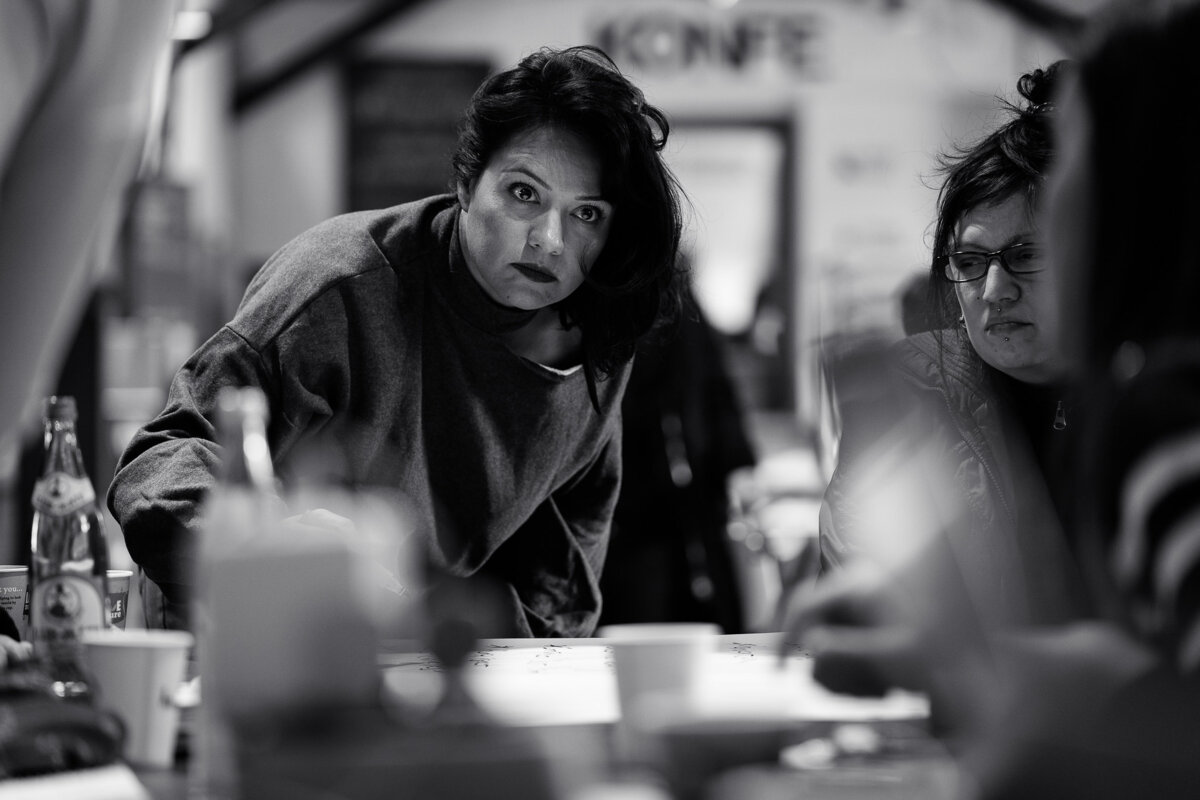
Agrandissement : Illustration 1

“Many Anglo-Europeans want to save those at the frontlines without respecting that people don't need saving, they need us to take care of the inequalities we cause and are complicit in”, states the human geographer Anja Kanngieser in this MORE WORLD interview. Thus, listening to those at the frontlines of climate change at places such as the Pacific islands becomes key in order to amplify what is generally silenced: the intertwined echoes of colonialism and capitalism. Opening our ears to that, means, last but not least, realizing the global entanglements and responsibilities that necessitate cooperative practices across borders.
Krystian Woznicki: What motivated your research on the populations and environments of Pacific islands such as Nauru that will be wiped out by sea-level rise resulting from climate change?
Anja Kanngieser: I was born and lived on a boat until I was 6 years old. My father was a boat builder, sailor and electrician, and I spent a lot of time living in New Caledonia, in the Pacific Ocean, when I was young. Growing up on the sea has embedded a relationship to these waters in me; I have very strong embodied memories of the places from this time, and they are in part what drew me back. My specific project began with conversations I followed on social media after the destruction wrought by Cyclone Winston in Fiji in early 2016. The international news was narrating a very limited story of climate vulnerability and the tragedy of 'natural disaster', focusing heavily on the trauma and impoverishment of Pacific communities. I was particularly aware of how little discourse in the news linked Winston to the actions of heavily industrialized countries in the 'Global North', despite the fact that it was clear that increasing cyclone velocity and intensity was due to anthropogenic (man-made) climate change. On my social media I was seeing a huge variety of responses, from anger and blaming climate change on environmental racism, to LGBTQIA communities self-organizing to bring resources to rural groups, to artistic and poetic testimonies, to highly conservative and religious admonitions, to outright denial.
My project is motivated by three aims. First, I want to show how climate change is part of a continuation of ongoing colonial and environmental violence in the region as opposed to some kind of 'natural' disaster, and that those of us descended from Anglo-European empires are heavily implicated in that violence. Second, I want to highlight the diversity of responses to climate change across the Pacific to push against narrow definitions of vulnerability and resilience. Third, the project exists to amplify campaigns and arguments for Pacific self-determination and self-representation in environmental justice.
KW: How did you progress from research on the experience of indigenous Pacific populations to creating the project "Climates of Listening"?
AK: Listening to, and with, Indigenous Pacific communities was how the project came about. My research has always been focused on how people work together to create the conditions that enable them to thrive in the face of capitalist violence. I think it’s really important to emphasize the ways people build solidarity and alliances to work across vast differences without forcing assimilation or agreement. For me with this project, I began with acknowledging that I am a white researcher who is part of a long legacy of white researchers and colonizers coming, oftentimes uninvited and with no respect for Indigenous research protocols, into Indigenous spaces. I spent many years speaking with people about the ethics and politics of what I was doing and made sure to approach people with an openness to refusal and critique. I think because I was very candid about inhabiting my subject position and putting that upfront, it may have allowed different relationships to develop over time. Listening was a huge part of this work of asking permission and making sure to leave where I was not wanted. I have been working with sound for over 15 years now, and in my practice I pay attention to how people speak – I listen to silences, to intonations, to evasions, and I try to take my cues not just from what people say but from how they say it. I also spend a lot of time listening to environments, and allowing what I hear – or don't hear – to shape my encounter with a place. Listening made sense for me as a method for this project because it helped highlight the essential ways that Indigenous Pacific communities are in dynamic relationship with, and reliant on, their lands and seas.
KW: Given the "otherworldliness" of the experience, would you say that there are things that you could not represent with an academic or journalistic book, and that you therefore chose to work with sound formats?
AK: There are many things that I do not know how to speak about from this project. I wouldn't describe it as an 'otherworldliness' because everywhere I went people had phones, were into pop culture, were worried about relationships/ work/ family, were very well versed in the changes they are seeing in their environments. I think it was important for me (as an Australian/ German) to deeply reflect on the historical and contemporary impacts of Australian and German colonization and imperialism on Pacific nations, from the overrepresentation of Australian aid and the ways that aid and economic development has impacted regional governance, to the insertion of German into Pacific languages from the legacy of German missionization (in Nauru and Papua New Guinea, for instance). These were things that really enabled me to have a visceral understanding of how entangled and nonlinear time is, and helped me to better make sense of and frame what I was hearing in terms of silent reefs, mangroves and forests. For me, starting from sound and silence is a way to unfold the broader reasons why these silences and sounds exist and in what ways.
KW: Are there things in your experience and research that are practically non-representable in a text book because they work at a level of knowledge that is either incompatible with Western notions of it or more embodied and sensual than intellectual? If so, how did sound become a way to represent such things?
AK: Again, silence is key to this. Silence in terms of refusal, silence in terms of things no longer being there, silence as reverence and as mourning. It’s very hard to capture these silences either in words or in sound, although a strong guiding work for me is Unaisi Nabobo-Baba's "On Knowing and Learning: An Indigenous Fijian Approach". I had many conversations with people about what can be told, and what should remain hidden from academics and outsiders, what was necessary to be silent about. There are also many things I was told that I will choose to be silent on until I find the correct ways to articulate them. I think what sound was really useful for in this process was registering the gaps, so that at least for me, I notice them each time I listen back over my recordings. Sound tells many different stories to people, and these stories are always changing. As i-Kiribati poet and educator Teweiariki Teaero told me: "Two ears, one mouth, don't talk too much. Learn to listen more. Not only to hear, but to be able to develop another thing and that is to be able to interpret. These things are different, they occur at different levels. The hearing and the interpretation of the sound...it's very much part of our world".
KW: In some sense your work explores forms of knowledge and knowledge production that are considered irrelevant or even seem to have been repressed in the Western canon. In a similar vein, indigenous cultures in the Pacific region also represent ways of dealing with climate change that are blocked out in the climate change conversation in the West. What are we in the West so far overlooking but should be aware of in our conversations on climate change?
AK: The arrogance, racism and colonial mentality of climate change discourses and activism in the 'Global North' permeates every level of engagement with climate change in frontline 'Global South' regions. This is also evident in the ways we approach regions impacted more heavily in the 'Global North' itself – places that see cyclones and flooding like New Orleans and Florida in the USA, or drought and bushfires in rural areas in Australia. Much environmental justice work shows how economically poor, Black, Indigenous and communities of color, particularly women, LGBTQIA and disabled people, are the most acutely affected by social-environmental change. The long history of structural inequality is often erased from climate change stories. This framing is critical to understanding how we (white Anglo-Europeans) are culpable in what is currently happening. I think unless we see this larger picture, we will keep having very narrow conversations that turn either to geo-technological solutions (the fetish of technology saving us) or despair and anxiety about how this will hurt coming generations. There are many brilliant Indigenous organizers like DIVA for Equality Fiji, Pacific Network on Globalisation, Kiribati Climate Action Network, and scholars like Tony Birch, Katerina Teaiwa, Craig Santos Perez, Zoe Todd, Nick Estes, who show that climate change is a continuation of this history rather than an exception to it.
KW: What does it mean for you to unlock this particular treasure trove of experience and knowledge and to translate it through sound into dominant conversations on climate change? Perhaps you could give us an example?
AK: I have been very privileged to go to places that many people will never go to. My work has enabled me to spend time with people in Fiji, Kiribati, the Marshall Islands, Nauru and Papua New Guinea. For many Anglo-Europeans especially, these are exotic locations a long way away, locations with which they have very little connection or understanding. By being able to play people the testimonies of Pacific communities, to be able to play the anger, the grief, the joy and the resistances, I hope that my work helps people develop a better understanding of what Pacific communities are experiencing – it’s one thing to represent someone’s life, and another to hear their voice or words as testimony. I also aim to show Anglo-Europeans how we are implicated in what is happening and what we need to do to address our legacies. At the same time, a significant part of my work is to bring the interviews and recordings to people from those islands living elsewhere, diaspora in Australia or the UK or on other Pacific Islands, for instance. To bring information to people about what I have been told that they might not get from media or from family, and to extend knowledge about what different organizations are doing regionally.
To play the recordings of reefs and forests, cities and islands, is to build an atmosphere through sound that is hard to describe. That includes playing these recordings to people who work in those environments every day. I will give two examples, one that pertains to playing my work back to Pacific Islanders and one that I use in speaking to an international audience. While I was in Fiji, I was invited to visit Nasilai village, where there had been extensive mangrove conservation, to see if I would get underwater recordings differing from the ones I had taken along the southwest coast of Viti Levu, which were largely silent. The chief of the village took me, a marine biologist from the University of the South Pacific, her friend, and his three young children out on the boat to the mangroves. I put my hydrophones in the water and immediately heard a cacophony of snapping shrimps interspersed with chirruping fish – a far more robust sonic ecology than any others I had yet encountered.
I gave the headphones to the chief to listen, expecting he would quickly hand them back. For the next 30 minutes, however, he sat hunched over the recording device, intently listening to the sounds of the mangroves. When he finally returned the headphones to me, he said that he had had no idea that there was anything down there. Because the water was opaque due to silt, he hadn't seen consistent evidence that their conservation efforts were paying off. While he had been told by scientists that fish breeding was occurring, he said this was the first time he understood that there were actually fish down there. A second example is a moment in Tarawa, the capital of Kiribati, that I often reference in conversations with non-Pacific people. While I was there in early 2018, there was an inundation event coinciding with a spring high tide. I was out with my friend and collaborator Krystelle Lavaki recording the waves, and we were watching the water rising higher and higher over the road, into animal pens: the pigs were up to their chests in seawater. As we saw the ocean rising up the beach and flooding villages, we saw young children running up and down the sand and sitting in the water on the road eating ice cream. In our recordings, you can hear the roar of the waves and the sound of coral crashing together interspersed with the kids’ laughter. I think the fact that this flooding was nothing out of the ordinary speaks of many things that are often left out of conversations on climate change.
KW: Did you encounter in your research on Pacific islands forms of resistance at the edge of climate change? If so, what kinds of forms of resistance have you witnessed and what are its immediate geopolitical contexts?
AK: There are many forms of resistance to climate change in the Pacific – from grassroots campaigning to government policies. But they all have to be qualified through the lens that there is very little that Pacific Island nations can do either to reduce global emissions or to mitigate global warming. People are very focused on adaptation measures – building sea walls, streamlining waste management, planting mangroves to mitigate coastal erosion, consolidating disaster response. But ultimately these are temporary measures: sea walls can only hold up so long, and if the sea rises by 3 meters, islands within Tuvalu and Kiribati will no longer exist. Communities are very determined to hold onto their lands; they have seen many iterations of colonization and resource extraction and endured extensive violence over the past century. But also, Pacific Islanders have inhabited their lands for many thousands, even tens of thousands of years. In many cases, being able to find ways to stay put, or if needed, to migrate with dignity, are the strongest forms of resistance that can be seen.
KW: What kind of insights into models for survival in the era of climate change are these particular forms of resistance providing? What are for you the most important insights? And how can the rest of the world learn from them?
AK: The greatest insight for me is asking: what does it mean to expect people to be resilient? There is a lot of conversation extolling the virtues of resilience in Indigenous communities without questioning the role of white Anglo-Europeans in placing people in situations where they have to struggle to live. We need to look at ourselves and reconfigure how we think about those who our actions erase, deny, compromise and kill. We need to figure out what we can do to hold ourselves, our friends, our families, our governments accountable and examine how we continually benefit off the white supremacy that relegates Black, Indigenous and Brown people to the status of not-human, as victim or hero. Many of the activists I spoke with said, "We are doing this not only for us, but for you, because after we go, you go too". They also emphasized how destructive racial capitalism is on the planet and how foundationally self-harming our entire ways of living are to humans and to multispecies ecologies. I think many Anglo-Europeans want to save those at the frontlines without respecting that people don't need saving, they need us to take care of the inequalities we cause and are complicit in.
KW: Talking further about your findings: In the context of the MORE WORLD initiative we are particularly interested in the migration aspect, specifically, in how climate change triggers migration movements, and possibly, how migration movements impact climate change. What are your observations in this regard?
AK: In the Pacific, people have already experienced extensive migration internally, that means, they have had to move between villages, cities, national islands and atolls. In 2014 the former president of Kiribati, Anote Tong, purchased land in Vanua Levu (Fiji) for i-Kiribati islanders to move to should their islands become fully submerged. This, from the outside, seems like a reasonable solution. However, as many i-Kiribati people I spoke with said, aside from their desire not to migrate, they did not feel that such a plan was viable. Firstly, because they are low-lying atoll people, reliant on the reef and sea, and the piece of land is further inland in Fiji, which would mean that they would need to learn entirely new skills for subsistence. Secondly, because the land has questionable arable potential, meaning there may be problems with growing food. Thirdly, because it would mean condensing villagers traditionally spread over dozens of islands into a much smaller bounded space, which could lead to conflict.
And finally, because Indigenous land tenure systems are very strong, people did not want to be on land that was not theirs. One thing that was being pushed for was migration with dignity – that if people do have to migrate internationally, that they would be able to choose where they go and under what circumstances. This need for self-determination in migration is crucial, and one we need to address, particularly as the reasons that frontline communities will be forced to relocate has nothing to do with their own practices; they are being impacted by environmental changes they have barely, if at all, contributed to. This must be expanded more broadly to a migration politics, whether due to climate change, war, dwindling resources and so on.
KW: As regards the political dimensions of communal practices among indigenous cultures on Pacific islands, I wonder whether and how a human rights perspective makes sense in this context: Is raising the issue of rights for indigenous cultures in the Pacific region a meaningful way to address the question of justice in the context of climate change? In other words: What are the politics of climate and environmental justice in the Pacific?
AK: Many of the Pacific groups I worked with and spoke to frame environmental justice as a human rights issue. The ability to access their lands, water, and resources is their inalienable right, and they are having those rights taken away due to circumstances beyond their control. Especially in national and international governance spaces, it makes sense to frame it in this way, because it also ties in with legal arguments around forced migration, ecocide and attributing culpability to major polluting companies and nations. This perspective means it is also possible to speak about loss and damages, and the impacts of climate change with regards to health, sexual and gender protections, and economic, social and cultural self-determination. As Noelene Nabulivou from DIVA for Equality Fiji commented to me, "If we say that we are looking at the ecosphere as an ecosphere, that we are conscious that we have limits as humans, that we live on a planet that is requiring care, just as we have to care for ourselves, then a justice approach is the only way. Really, it's the only way. Because if you just keep teching your way out of problems, if you just keep trying to kind of tweak the system, if the system is unhealthy, which it is, if we have a capitalist system that is running riot over our bodies and our environment, then without an approach that is about justice, that is about the basic core fundamentals of living on an Earth that has limits, where we have to negotiate power and space, we won't ever repair what we've lost and transform and renew.
That's really the justice question, because once you take it down to a justice question, then all systems can be challenged. Justice for me is about living in love and equity and wholeness with others. So it's a little tough to put forward the same old stupid strategies, if that is your real goal, if justice is your goal. Even human rights can be hijacked. But a justice approach is getting to the core of what it is to be human, but also to be human with other species, and to be human in a finite landscape. That's a justice approach. And then we look up at that lovely thing there, which is, people are so ready, it says "No justice without bodily autonomy." And we tried to do this thing, and I think this is where feminist praxis around ‘personal is political’ is so important. You can't have a just system unless the system works for all within it. And that is one of the most revolutionary concepts: how do you weave a system that is just for all? It's very hard because it goes to the core of everything."
KW: In what sense do you see indigenous folks in the Pacific region becoming political actors in their own right vis-à-vis climate change?
AK: Indigenous people in the Pacific have always been political actors. They have lived on and taken care of their islands far longer than Anglo-European invasion and will continue to do so whatever the futures hold. As Papua New Guinean activist and politician Gary Juffa has put it, "Our seas and our forests are what have sustained us for thousands of years, and we should not be convinced by entities that are driven primarily by profit and greed that we are going to suddenly starve to death and become extinct as a people. We've lived for thousands of years in this area without money, without profit, without greed. We can continue to live for another thousand years or more."
Join the MORE WORLD project!
The BG’s 20th anniversary project MORE WORLD invites you to explore together cooperative practices that tackle climate change. To this end, the BG will organize a big conference at the end of the year, offering a diverse program of workshops bringing together people from more than 25 countries. The call for registration invites you to join the workshops. Further information can be found on this website: more-world.berlinergazette.de
About Anja Kanngieser
Anja Kanngieser is a human geographer with a background combining geography and communication studies. She has an international reputation for advancing social science research through the arts and the geo-humanities. She is best known for her use of creative ethnographic methods to examine how grassroots communities in both the Global North (Europe) and Global South (Asia-Pacific) narrate their contestation of social, political, economic and environmental adversity. More about her work here.



